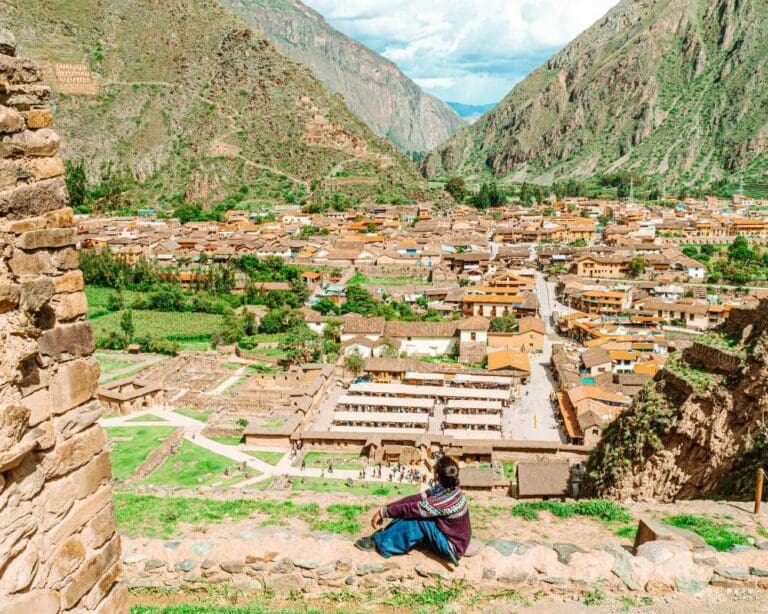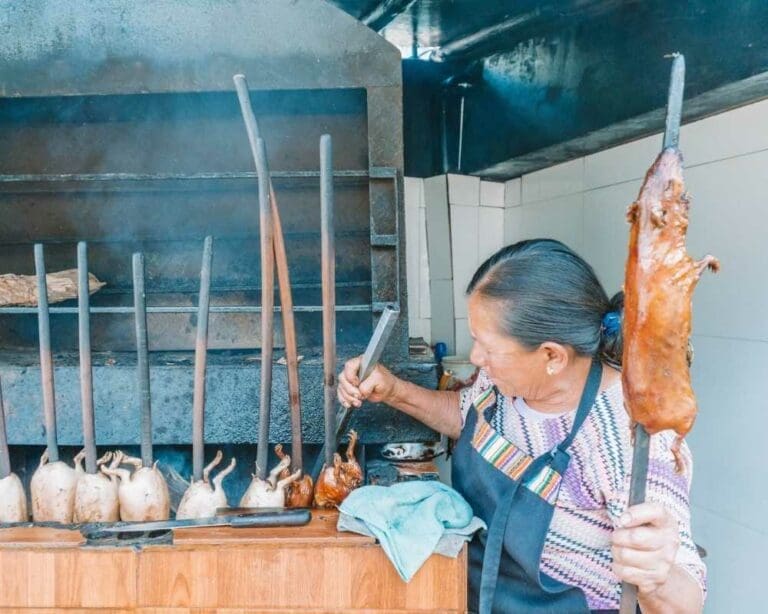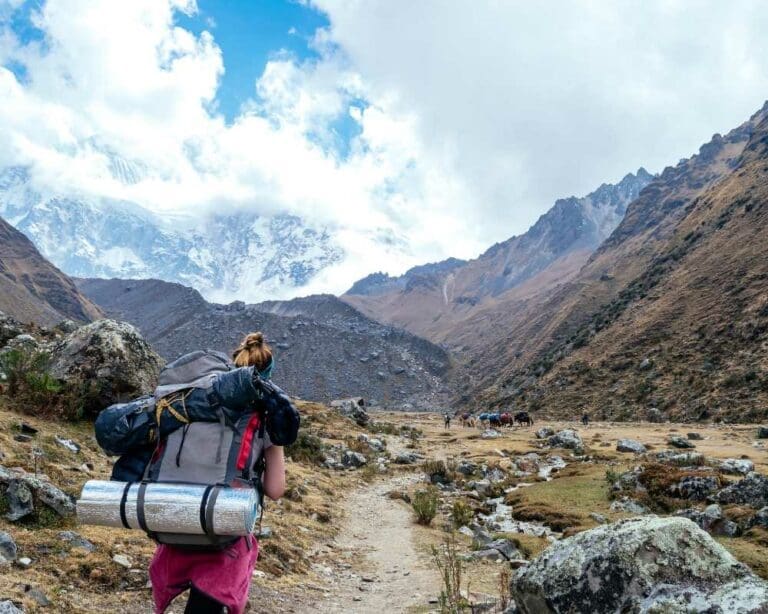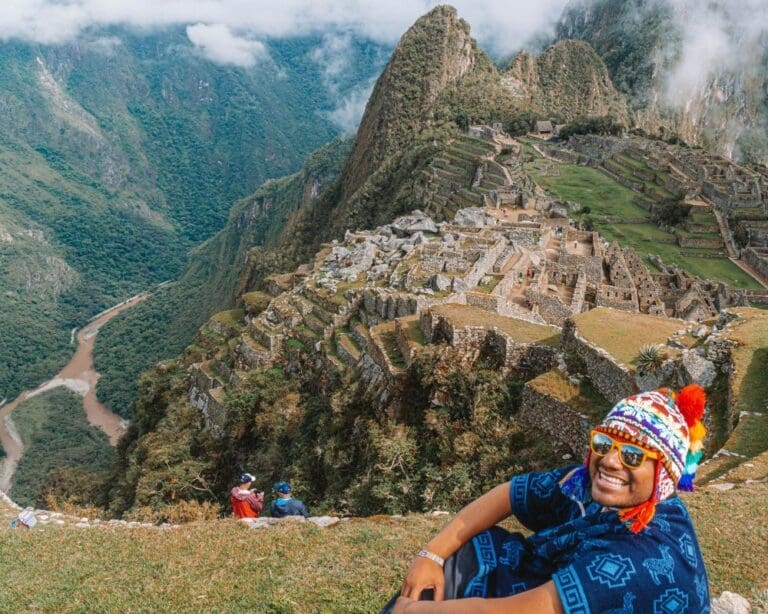Peru Insider’s 23 best things to do in Machu Picchu
Here are the best things to do in the Machu Picchu citadel with a map where you can see the photography spots in this Incan wonder!
Hola! Welcome to Machu Picchu! First off, this things to do in Machu Picchu article only covers the complex of Machu Picchu (Citadel). This will help you easily navigate the complex without a guide.
Machu Picchu is big and while a free map is included in this article (download link below!), it’s still advisable to hire a guide to learn more about this world-famous site.

If you are not hiring a guide, you can take your own time and stop in these Machu Picchu Instagram spots without having to rush with the tour groups. Machu Picchu offers a myriad of experiences that transcend the ordinary so plan your route accordingly.
Inform yourself about the layout of Machu Picchu to avoid the crowds. There are many Machu Picchu spots in this article that not all travelers know, especially those who are dependent on the tour groups.
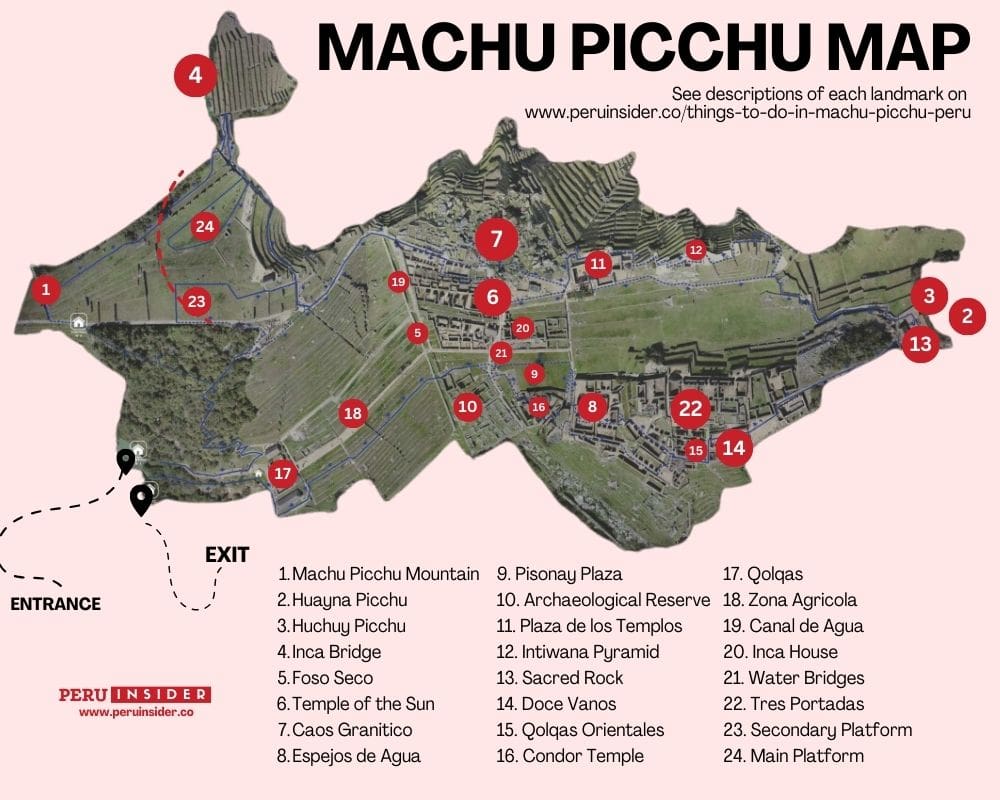
Download your FREE MACHU PICCHU MAP!
Download this Machu Picchu Map and use it for your trip. Receive 2 versions of this map via e-mail instantly!
Here are the best things to do in Machu Picchu together with information on how to access each ruins/site.
1. Ascend Machu Picchu Mountain

Machu Picchu Mountain is one of the two peaks that tourists can climb to gain a bird’s eye view of the Machu Picchu citadel and the surrounding Andean landscape.
Ascending Machu Picchu Mountain is an exhilarating experience that rewards hikers with some of the most stunning views over the entire Machu Picchu archaeological site and beyond.
This mountain, towering above the iconic ruins, offers a challenging yet profoundly rewarding trek. The ascent involves a steep trail that takes approximately 1.5 to 2 hours to climb, depending on your pace.
Access to Machu Picchu Mountain requires a separate ticket, which must be purchased in addition to the general admission ticket to Machu Picchu. It’s crucial to book this ticket well in advance due to limited availability.
For a truly unforgettable experience, time your ascent to catch the sunrise over Machu Picchu. This requires an early start, around 4:00 AM from Aguas Calientes.
🎟️ Recommended: Machu Picchu Tickets Purchasing Guide
2. Climb Huayna Picchu: best of the best things to do in Machu Picchu

Huayna Picchu is the mountain that forms the backdrop to the classic Machu Picchu postcard view. It is famous for its steep paths and the unique perspective it offers of the citadel below.
Climbing Huayna Picchu is among the most thrilling things to do in Machu Picchu, offering adventurers breathtaking panoramic views and a closer look at the Incan engineering marvels.
The path is steep and narrow, winding its way up the mountain that towers over the Machu Picchu ruins. The climb is strenuous but manageable, leading to ancient terraces and the famous Temple of the Moon.
To climb Huayna Picchu, you must purchase a specific ticket that includes entry to this peak, in addition to the main Machu Picchu ticket. Access is limited to 400 people per day, split into two groups, so booking several months in advance is essential.
Choose the second entry time to Huayna Picchu if you prefer a slightly less crowded path and warmer weather. The sun often burns off the morning mist by midday, offering clearer views and a more pleasant climb.
3. Explore Huchuy Picchu

Huchuy Picchu is the smallest of the three mountains accessible to visitors at the Machu Picchu site. It offers easier trails and equally rewarding views of the ruins and surrounding landscapes.
Exploring Huchuy Picchu offers a less strenuous alternative to its larger neighbors, making it a perfect option for families or those seeking a more moderate hike.
Huchuy Picchu, meaning “Little Peak” in Quechua, provides a unique vantage point with less foot traffic, allowing for a quieter, more intimate experience with nature and ancient Incan architecture.
Tickets to Huchuy Picchu are included with some Machu Picchu entry tickets, combined with the Machu Picchu Circuit 4 route.. The hike is relatively short, taking about 45 minutes to an hour to complete.
After exploring Huchuy Picchu, take some time to relax at the nearby terraces. These spots are often less crowded, offering a peaceful moment to reflect on the majesty of the ancient site and its natural surroundings.
🚌 See also: How to get from Cusco to Machu Picchu in 6 ways
4. Explore the Inca Bridge

The Inca Bridge is a small but significant part of the Machu Picchu citadel, offering insight into the military genius of the Incan civilization and their ability to integrate architecture seamlessly with the natural landscape.
It is an essential activity for history enthusiasts and adventure seekers alike. This narrow path carved into a cliff face showcases the ingenuity of Incan engineering.
The bridge, part of an ancient trail network, was a strategic military checkpoint that could be easily defended by removing its wooden planks.
The Inca Bridge can be accessed via a short walk from the main Machu Picchu complex. No additional ticket is required, making it an easy addition to any visit.
For safety reasons, crossing the bridge is prohibited. The bridge is an ancient structure, consisting of a narrow path cut into the cliff face with a gap that was bridged by wooden planks.
🦙 Join our 14-day Peru expedition!

Discover Peru from Lima to Cusco on a 14-day expedition with the coolest travelers on the block! Our group trips to Peru are joined by a super fun and dynamic group of travelers of all ages!
5. Wander in Foso Seco (dry moat)

Wandering in Foso Seco offers a unique glimpse into the defensive strategies of the Inca civilization, making it a fascinating thing to do in Machu Picchu for history enthusiasts.
Foso Seco, or the ‘Dry Moat,’ is a strategic architectural feature designed to protect the citadel. Unlike traditional moats, it doesn’t contain water but instead serves as a deep trench surrounding part of the site, demonstrating the Incas’ ingenuity in utilizing the landscape for defense.
This area allows visitors to appreciate the thoughtfulness and complexity behind the planning and construction of Machu Picchu.
Access to Foso Seco is included with the general admission ticket to Machu Picchu. It can be found on the outskirts of the archaeological site, easily accessible by following the signposted paths.
💰 You might also like: Machu Picchu trip cost breakdown
6. Go to the viewpoint of the Temple of the Sun

One of the essential things to do in Machu Picchu is to visit the viewpoint of the Temple of the Sun. The Temple of the Sun is a significant ceremonial structure within Machu Picchu, designed to worship the sun god, Inti.
Its semicircular construction and strategic windows demonstrate the Incas’ architectural and astronomical knowledge.
The viewpoint is accessible with the general admission ticket to Machu Picchu. It is well-signposted within the site, making it easy to find as you follow the main path through the ruins.
For an enhanced experience, time your visit to the viewpoint during the early morning hours. The soft morning light illuminates the temple beautifully, providing a serene atmosphere away from the peak visitor times.
7. Marvel at Caos Granitico

Among the unique things to do in Machu Picchu is to marvel at Caos Granitico. Caos Granitico is a geological feature within Machu Picchu, characterized by its chaotic arrangement of granite rocks and boulders, highlighting the natural beauty and geological complexity of the area.
This area can be explored as part of the general visit to Machu Picchu, with no special access required. It is located near the central part of the site, easily reachable by following the designated paths.
Bring a camera with a good zoom lens to capture the intricate textures and forms of Caos Granitico. Early morning or late afternoon light can enhance the natural beauty of the granite, creating stunning photographic opportunities.
🚍 Recommended: How to get to Machu Picchu in 17 ways
8. Reflect at Espejose de Agua (water mirrors)

Reflecting at Espejos de Agua, or ‘Water Mirrors,’ is one of the more serene things to do in Machu Picchu. These natural pools, formed by rainwater collecting in hollows on the rock surfaces, offer a moment of tranquility and reflection.
The still water creates a mirror effect, beautifully reflecting the sky and the surrounding peaks. This phenomenon not only highlights the Incas’ reverence for water and its symbolic importance in their culture but also provides a unique photographic opportunity for visitors.
Located within the Machu Picchu site, access to Espejos de Agua is included with the general admission ticket. These natural pools can be found while exploring the site, particularly in the agricultural sector.
9. Wander through Pisonay Plaza

Wandering through Pisonay Plaza is a delightful way to immerse yourself in the daily life and social hub of ancient Machu Picchu. This central square, surrounded by important buildings and terraces, would have been a bustling area in its time.
Today, it offers visitors a sense of the community and architectural planning that characterized the Inca civilization. The plaza is named after the Pisonay trees that once adorned the area, adding to its beauty and significance as a gathering place.
Access to Pisonay Plaza is straightforward with a general admission ticket to Machu Picchu. It is centrally located within the archaeological site, making it an unmissable part of any visit.
Take a moment to sit and observe the plaza. Imagine the gatherings and ceremonies that would have taken place here, allowing the history and energy of the space to envelop you. This contemplative approach offers a deeper connection to the site and its past inhabitants.
🥾 Recommended: What to pack for Machu Picchu
10. Discover the Machu Picchu Archaeological Reserve
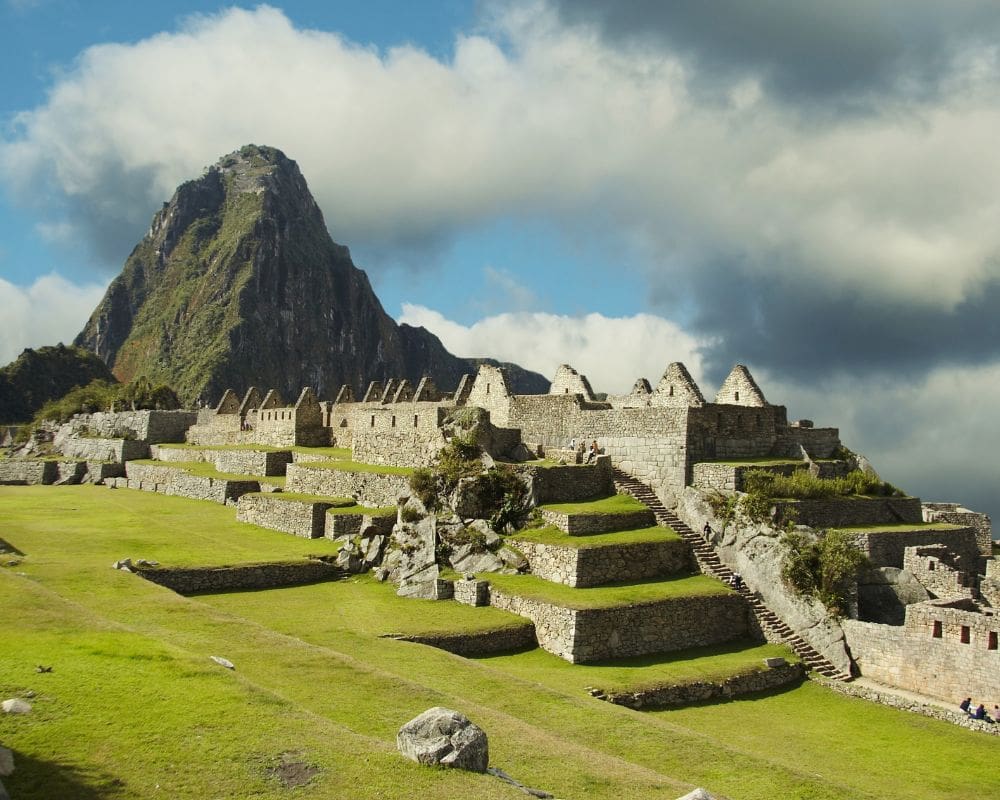
Discovering the Machu Picchu Archaeological Reserve is arguably the most comprehensive thing to do in Machu Picchu for those looking to fully appreciate the scope and significance of this UNESCO World Heritage site.
The reserve encompasses the entire archaeological complex, including the iconic ruins, agricultural terraces, and natural features like the surrounding mountains and forests.
The Machu Picchu Archaeological Reserve is the entire protected area that includes the ruins, agricultural areas, and natural landscapes that make up the Machu Picchu site.
Entry to the archaeological reserve is granted through the purchase of a general admission ticket to Machu Picchu. Visitors can explore the reserve by following the designated paths that lead through the ruins and surrounding areas.
11. Admire Plaza de Los Templos

Admiring Plaza de Los Templos is one of the most spiritual things to do in Machu Picchu.
Plaza de Los Templos is a central ceremonial area within Machu Picchu, featuring several significant religious structures, including the Principal Temple, the Three-Windowed Temple, and the Intiwatana stone.
This sacred square is home to some of the most important religious constructions in the ancient city, including temples and ceremonial altars. The craftsmanship of the stonework here is unparalleled, showcasing the Inca’s sophisticated architectural techniques and their deep reverence for their deities.
Access to the plaza is included in the general admission ticket to Machu Picchu. It is located within the urban sector of the site and is easily accessible via the network of paths throughout the ruins.
🚫 You might also like: Is it safe to travel to Machu Picchu?
12. Learn about the Intiwatana Pyramid

Learning about the Intiwatana Pyramid is a fascinating addition to any list of things to do in Machu Picchu. The Intiwatana, meaning ‘hitching post of the sun’ in Quechua, is a carved rock pillar used by the Incas as an astronomical clock or calendar.
It is believed to have been used by the Inca astronomers for tracking the sun’s path to predict solstices and equinoxes.
Situated on a raised platform that offers spectacular views of the surrounding mountains, the Intiwatana Pyramid is a testament to the Incas’ advanced knowledge of astronomy and their deep connection to the natural world.
This site provides an insight into how the Incas harmonized their architectural, agricultural, and religious practices with the celestial movements.
The Intiwatana Pyramid is accessible to all visitors with a general admission ticket to Machu Picchu. It is perched atop a hill within the site and can be reached by following the main path through the ruins.
13. Contemplate on the Sacred Rock (Roca Sagrada)

Contemplating on the Sacred Rock is an essential experience for those seeking a deeper understanding of Inca spirituality.
The Sacred Rock is a large carved boulder within Machu Picchu, thought to have been used for religious ceremonies and as a symbol of the Inca’s connection to the earth and mountains.
Located in a tranquil area of Machu Picchu, the Sacred Rock provides a peaceful space for visitors to reflect on the connection between Inca culture and the natural world. This site embodies the Incas’ reverence for Pachamama (Mother Earth) and their sophisticated landscape architecture.
This spiritual site is included in the general Machu Picchu visit and can be found in the lower part of the urban sector, easily accessible by walking from the main areas of the ruins.
⛰️ Recommended: The ultimate guide to the Choquequirao Trek to Machu Picchu
14. See Inca architecture at Doce Vanos

Seeing Inca architecture at Doce Vanos is a must-do for architecture enthusiasts and history buffs visiting Machu Picchu. Doce Vanos, or the Twelve Angles Stone, is a notable architectural feature within Machu Picchu, showcasing the Incas’ sophisticated stone masonry techniques.
This architectural feature demonstrates the precision and skill with which the Inca builders carved and fitted stones without the use of mortar.
Included in the general admission, Doce Vanos is located within the urban sector of Machu Picchu and is easily accessible.
15. Uncover the history behind Qolcas Orientales

The Qolcas Orientales is a must for those interested in the economic and agricultural ingenuity of the Inca civilization, making it a fascinating item on the list of things to do in Machu Picchu.
Qolcas Orientales are ancient Incan granaries within the Machu Picchu site, used by the Incas for storing surplus crops, such as potatoes and maize, to be used in times of scarcity.
These structures, built with ventilation systems to keep the produce dry, highlight the Incas’ advanced understanding of agricultural practices and food security.
These historical structures are included in the general exploration of Machu Picchu and can be found on the outskirts of the main archaeological area, highlighting the practical aspects of Incan society.
✈️ Related: How to get to Machu Picchu from Lima in 6 steps
16. Visit the Condor Temple

Visiting the Condor Temple is an essential experience for those exploring Machu Picchu, offering insight into the spiritual and ceremonial practices of the Inca civilization.
This sacred site is named for its rock formations, which resemble the wings of a condor, a bird of significant importance in Inca mythology and cosmology.
The temple served as a center for rituals, including those related to the afterlife and the condor, believed to carry the dead to the upper world.
The temple is accessible to visitors holding a general admission ticket to Machu Picchu. It is located within the religious sector of the site, easily found while exploring the ruins.
17. Examine the Qolqas

The Qolqas at Machu Picchu is a compelling activity for visitors interested in understanding the logistical and economic systems of the Inca Empire.
Qolqas are ancient storage buildings used by the Incas, found throughout the Machu Picchu site, showcasing their advanced resource management systems.
These structures served as storehouses for food, textiles, and other goods, playing a crucial role in the Incas’ ability to manage their resources, support their population, and sustain their expansive empire.
The design and placement of the Qolqas reflect the Incas’ strategic thinking and architectural ingenuity.
Access to the Qolqas is included with the general admission ticket to Machu Picchu. They are scattered around the site, with some located near agricultural areas and others close to residential sectors.
18. Observe the Zona Agricola

The Zona Agricola, or Agricultural Zone, is a must-do for visitors to Machu Picchu interested in the farming practices and sustainability strategies of the Inca civilization.
The Zona Agricola comprises terraced fields that were part of Machu Picchu’s extensive agricultural infrastructure, essential for supporting the city’s population.
This area consists of extensive terraces that were used for cultivation, demonstrating the Incas’ ability to adapt to their environment and maximize agricultural output. The terracing system also played a role in preventing erosion and managing water resources, underscoring the sustainability practices of the Incas.
The agricultural terraces are visible upon entering Machu Picchu and can be explored with a general admission ticket. They envelop the site, offering numerous vantage points for observation.
19. Follow the Canal de Agua

Canal de Agua is an enlightening experience for those fascinated by the engineering prowess of the Inca civilization. This intricate network of water channels was used to distribute water throughout Machu Picchu, from the springs on the mountainside to the urban and agricultural sectors.
The system highlights the Incas’ sophisticated understanding of hydraulics and their commitment to sustainability and the well-being of their community.
The canal can be observed as part of a general visit to Machu Picchu. It runs through the site, and its starting point near the entrance is easily accessible for visitors to follow its course.
20. Tour The Inka House

The Inka House is an engaging activity for visitors to Machu Picchu, offering a glimpse into the domestic life of the Inca elite. This well-preserved structure is believed to have been the residence of high-ranking officials or priests, providing insights into the architectural design and living conditions of the time.
The Inka House features characteristic stone masonry, trapezoidal doorways, and niches that were typical of Inca architecture, reflecting the sophistication and functionality of their residential buildings.
The Inka House is a significant residential structure within Machu Picchu, showcasing the living standards and architectural preferences of the Inca elite.
Included with the general admission ticket to Machu Picchu, The Inka House is located within the urban sector of the site and is accessible via the main pathways that crisscross the ruins.
21. Traverse the Water Bridges

The Water Bridges is a captivating thing to do in Machu Picchu for those interested in the Inca’s mastery of water management. These bridges were part of an extensive network of aqueducts and channels designed to distribute water throughout the city for agricultural, domestic, and ceremonial use.
The Water Bridges, specifically, highlight the Inca’s engineering prowess, as they allowed for the efficient movement of water across difficult terrain, ensuring the sustainability of their mountain-top sanctuary.
The Water Bridges are part of Machu Picchu’s sophisticated water management system, consisting of channels that transported water across various terrains.
The Water Bridges can be seen as part of exploring Machu Picchu with a general admission ticket. They are integrated into the site’s landscape, with several examples visible along the paths and near agricultural terraces.
22. Appreciate Tres Portadas

Tres Portadas, or the Three Doorways, is a must for those exploring Machu Picchu, highlighting the aesthetic and functional aspects of Inca architecture. This architectural feature consists of three symmetrically arranged doorways leading into what is believed to have been an important ceremonial or administrative complex.
The harmonious design and precision of Tres Portadas exemplify the Incas’ architectural excellence and their emphasis on symmetry and balance in construction.
Located in the central part of Machu Picchu, Tres Portadas is accessible to all visitors with an Inca Trail hike ticket.
23. Take photos with the llamas!

Llamas are synonymous with the scenic landscapes of Machu Picchu, often found grazing on the lush terraces or wandering freely among the ruins.
These friendly and curious creatures have become one of the site’s many charming attractions, offering visitors a unique opportunity to interact with local wildlife against the backdrop of ancient Incan architecture.
Llamas can typically be found throughout the Machu Picchu complex, as they are allowed to roam freely within the site. However, there are a few spots where you’re more likely to encounter them:
- Agricultural Terraces: Llamas often graze on the extensive terraced slopes that surround Machu Picchu. These terraces are located just as you enter the site, providing an early opportunity for llama sightings.
- Central Plaza: The central open area within Machu Picchu’s urban sector is another common gathering spot for llamas. Here, they can be seen enjoying the grass and occasionally interacting with visitors.
- Near the Guardhouse: The area around the Guardhouse, which offers one of the classic views of Machu Picchu, is also a favorite spot for llamas. The panoramic vistas here make for an excellent backdrop for photos.
Approach gently. Llamas are generally friendly but can be skittish around sudden movements. Approach them slowly and calmly to avoid startling them.
Always maintain a respectful distance. If a llama seems uncomfortable or begins to move away, do not attempt to follow or touch it.
Looking for more Machu Picchu travel guides?

